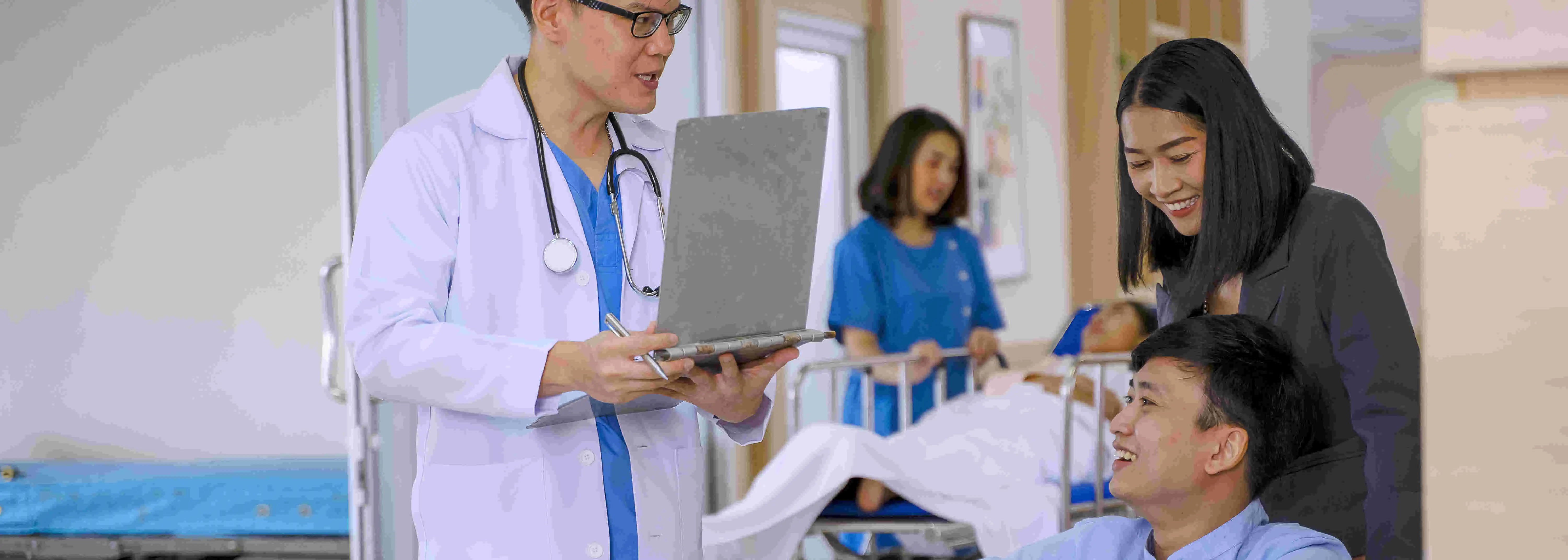Orthopaedics is the branch of medicine that deals with the diagnosis and treatment of the musculoskeletal system (bones, joints, muscles, ligaments, tendons, cartilage).
The musculoskeletal system in the human body helps you to move and perform other everyday activities such as walking, jumping, and moving the body.

Diagnose and treat musculoskeletal conditions
Common conditions that orthopaedic doctors treat include osteoarthritis, neck, back, and shoulder pain, bone fractures, soft tissue (ligament, tendon, muscle) injuries such as sprains and strains, and congenital conditions (scoliosis, clubfoot).
The R.I.C.E. method is a common initial treatment used to relieve pain, swelling, and speed up the healing process.
Perform surgical and non-surgical treatments and procedures
Surgical treatments such as total hip replacement, total knee replacement (TKR), arthroscopy (keyhole surgery), carpal tunnel release, trigger finger release, corrective spine osteotomy, lumbar discectomy, laminectomy, etc are performed depending on the type of orthopaedic condition.
Non-surgical treatments intervention such as physiotherapy (TENS, warm compression, stretching exercises, nerve gliding exercise) may be suggested as well because not every musculoskeletal condition requires surgery.
Pain management
Minimally invasive procedure such as local / trigger point injection, PRP (Platelet Rich Plasma), and Radiofrequency Ablation can be used for pain management.
Conditions treated by orthopaedic doctors
An orthopaedic doctor specialises in diagnosing and treating the following common conditions.
Arthritis
Arthritis is a condition when one or more of the joints are inflamed. There are several types of arthritis such as osteoarthritis, rheumatoid arthritis, post-traumatic arthritis, and septic arthritis.
Osteoporosis
Osteoporosis is a disease characterised by a reduction in bone density and bone mass. This would not only decrease bone strength but can lead to low impact trauma fractures (broken bones). Most common osteoporotic fractures occur in the hip, vertebra (spine bone) and wrist.
Carpal Tunnel Syndrome
Carpal tunnel syndrome is a condition that causes numbness, and tingling sensation in your hands and fingers. Carpal tunnel syndrome occurs when the median nerve is compressed and entrapped. If carpal tunnel syndrome is left untreated for an extended period of time, it can worsen and cause dysfunction of the hand, including loss of sensation in the fingers.
Chondromalacia Patellae (CMP)
Chondromalacia patella is a breakdown of the articular cartilage on the underside of the kneecap. Since articular cartilage does not contain nerves, it cannot directly cause pain if it is damaged. However, it may result in pain due to injury to the underlying subchondral bone and synovial inflammation. It can be due to direct trauma to the joint articular surface or sports injury.
Tennis Elbow (Lateral Epicondylitis)
Tennis elbow or lateral epicondylitis refers to pain and tenderness on the outside of the elbow caused by inflammation of one of the tendons that attach the forearm muscles to the elbow. The forearm muscles and tendons become damaged from overuse. Pain can be felt in the forearm.
Spine conditions
Spine conditions include disc degeneration (intervertebral disks tend to wear and shrink), degenerative spondylolisthesis (difficulty for the spine to be in correct position), spinal stenosis (spinal cord narrows and adds pressure on the cord and spinal nerves), and scoliosis (abnormal curve of the spine).
Sciatica
Sciatica occurs when there is pain in the lower back or hip which will then radiate to the thigh and legs. It is a type of nerve pain and usually affects the lumbar spine when it is compressed. The condition typically heals itself, however, non-surgical treatments are used to help manage the pain.
Achilles Tendonitis
The Achilles tendon is the large tendon in the back of the ankle that connects the calf muscles to the heel bone. These muscles are essential for walking, running, and jumping. The Achilles Tendon withstands a great deal of stress during normal daily life. Achilles Tendonitis occurs when the muscles and tendon are overused, causing irritation and inflammation of the tendon.
Sports Injuries & Trauma
Sports injuries occur while playing sports or exercising. Sports injuries can result from accidents, poor training practices, inadequate equipment, and overuse of a body part. Not warming up or stretching enough before play or exercise can also lead to injuries.
Some of the common sports injuries include sprains and strains, ligament (ACL, PCL, MCL, LCL) tears, meniscus tear rotator cuff injuries, fractures, dislocations, tendon tear.
Trauma:
When to visit an orthopaedic specialist
Consider making an appointment with an orthopaedic specialist if:
Make an appointment at Gleneagles Hospitals
Speak to your doctor to know more about the symptoms, diagnosis, and treatment for orthopaedic conditions. The caring and multidisciplinary team of healthcare professionals are available for consultation and to provide the best care.
Get in touch with us to book an appointment with an Orthopaedic specialist at Gleneagles Hospital today.
If you encounter a situation that requires medical attention, please seek immediate medical attention at the Accident and Emergency (A&E) department at your nearest Gleneagles Hospital.

Wait a minute